-
GEMSTONES - INFO AND CARE
Gemstones are almost always single minerals such as diamond, corundum (ruby and sapphire) and beryl (emerald and aquamarine). Notable exceptions are: lapis lazuli which is a rock composed of different minerals; and organic gems such as those from the animal kingdom (pearl and coral) and those from the vegetable kingdom (amber and jet). There are over 4000 known minerals but only about 100 have the qualities necessary to be prized as gems and of these about 20 constitute the major commercial gemstones; the others being collectors or connoisseurs stones. Below is a summary of gemstone basics as well as detailed information on individual gemstones.
Attributes of Gemstones
In order to be considered a gemstone, a mineral or material must have three cardinal virtues: beauty, durability and rarity.
Gemstones by definition must be beautiful. What defines beauty depends on the gemstone: transparency and depth of colour in the case of ruby and emerald; colour only in opaque gems such as turquoise; fire, brilliance and the absence of colour in diamond; and various phenomena such as "play of colour" in opal.
The second virtue is durability, the ability to withstand wear, damage or decay. As valuable ornaments gemstones should be able to resist abrasive influences that tend to destroy beauty and lustre. These influences include sand and dust particles in the air, being rubbed against other objects and chemical damage caused by contact with everyday substances and pollutants in the atmosphere. Durability is primarily governed by hardness (the ability to resist scratching) and toughness (the ability to resist breaking). Typically gemstones are hard, tough minerals.
Often of far greater influence than beauty or durability is the third virtue, rarity. A mineral may be fairly common in nature yet really fine pieces suitable for cutting may be quite rare. An example is emerald. The law of supply and demand governs to a certain extent the rarity of gemstones. All gems are rare amongst minerals in general but rarity is relative; citrine is one of the more common gems but it is very popular and extremely attractive in fine colour and quality.
Precious and Semi-Precious
Historically, gemstones have been divided into two classes as precious and semi-precious stones. Precious stones according to the Ancient Greeks were diamond, ruby, emerald and sapphire, and over time pearl and black opal often came to be included; all stones for which the value of fine specimens is high and demand is fairly constant. Such a traditional division is quite arbitrary and does not accurately reflect the modern trade. Some stones are largely inexpensive, as is garnet, but there are green varieties of garnet, namely tsavorite and demantoid, which can be more expensive than diamond. The term semi-precious is obsolete. Any attractive in-demand mineral or organic material with the requisite qualities of a gemstone is a gemstone, period.
There is no universally accepted method of grading coloured gemstones although in general they are assessed on the basis of the traditional 4 Cs: clarity, colour, cut and carat weight. The modification being that with different species there is different weighting on each category. Clarity grading in coloured gemstones is based on the eye-clean standard meaning a gem is considered flawless if no inclusions are visible with the unaided eye (assuming 20/20 vision). The Gemological Institute of America classifies tanzanite as a Type I gemstone, meaning it is normally eye-clean. In this category gems with eye-visible inclusions will be traded at deep discounts. Type II gemstones are usually included with eye-clean a much greater rarity; for example, ruby and sapphire. Type III gemstones are almost always included and even gemstones with noticeable inclusions are used in jewellery, such as emerald and rubellite.
Hardness
Hardness when it refers to gemstones is the ability to resist being scratched or abraded. Gemstone hardness is traditionally measured on the Mohs' scale, devised by German mineralogist Friedrich Mohs in 1812. Mohs' proposed a series of ten readily available minerals with reasonably constant hardness and set them in order, softer to harder.
MOHS HARDNESS 10. Diamond 9. Corundum 8. Topaz 7. Quartz 6. Feldspar 5. Apatite 4. Fluorite 3. Calcite 2. Gypsum 1. Talc
This is not a linear scale and the intervals between the numbers are not equal. In fact, the difference in hardness between diamond (10) and corundum (9) is greater than that between corundum (9) and the softest mineral, talc (1). It is simply an ordinal scale that sets topaz as softer than corundum and quartz as harder than feldspar. Dust contains microscopic particles of sand which are pulverized quartz (7) so any gemstone softer than this will easily show wear from general use unless special care is exercised. Rubbing a gemstone on one's sleeve or wiping it with a cloth to clean it grinds these particles across the surface in an abrasive action that will eventually destroy beauty and lustre.
The harder a mineral is, the higher the polish it will take. Sapphire (9) takes a better polish and exhibits a higher lustre than topaz (8). Diamond is the hardest mineral and has the best lustre of all, referred to as adamantine. The harder a mineral is the longer it will take to cut and therefore the more expensive it will be to fashion. Understanding hardness helps clients to appreciate proper care of their gemstones which in turn preserves their beauty and value. Never toss gemstones together in a reckless manner. All fine stones should be stored separately to prevent them from coming into contact with each other. This is particularly important where diamond is involved as it readily does harm to other softer gemstones.
DIAMOND
Diamond is a solid form of the element carbon. Diamond derives its name from the Greek "adamas" meaning unalterable or unbreakable. Diamonds have been treasured since their use as religious icons in Ancient India 6000 years ago although their use as tools for engraving has been documented to early human history. Diamond remains the most prized of all the gemstones. It is primarily thought of as a colourless gem; however diamond is naturally found in all colour varieties: red, orange, yellow, green, blue, violet, black, white, grey, purple, orange, pink and olive. These stones are referred to as fancies in the trade. All fancies are very rare in fine quality, some more than others: red, green, violet and blue are the rarest. The finest stones can command over $1 million USD per carat.
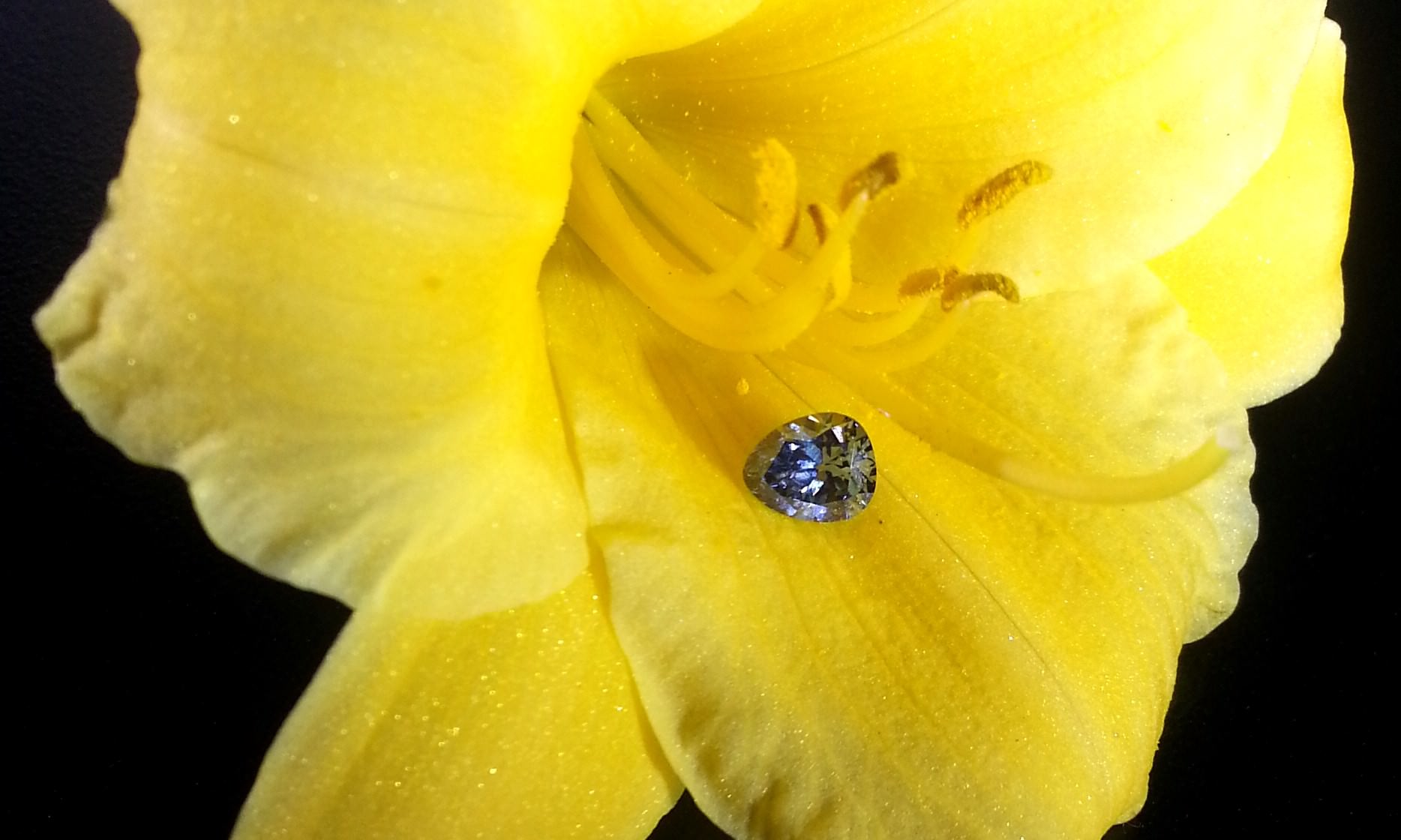
Magnificent Fancy Deep Blue pear shaped diamond acquired through the
DEEDEE Fancy Diamond Concierge service
Diamonds are graded for commercial purposes on the basis of the modern-day 4 Cs: carat, colour, clarity and cut. Carat refers to metric carat weight. Colour refers to grades of body colour ranging from the ideal colourless state. Clarity grades describe the increasing presence of inclusions from the ideal flawless state. And cut grading assesses the effect of proportions and faceting quality on overall beauty and brilliance.
The extreme hardness of diamond, 10 on the Mohs' scale, is its most famous property. It is a directional property in which variations can exceed 100:1. It is due to directional hardness that diamond can be cut at all. Diamond can only be cut by diamond but never in its hardest direction. Diamond exhibits significant toughness, the ability to withstand disruptive stress; however, it is only extremely resistant to stress applied as a slow force such as squeezing in a vice and less able to stand up to sharp stress such as force applied by a blow. This is often enough to induce cleavage and break the diamond. Cleavage refers to the tendency of a crystalline substance to split parallel to certain definite directions, in response to force, leaving a basically smooth flat surface. The property is likened to the tendency of wood to be split along the grain.
Diamond is the hardest and toughest of all gemstones and requires very little special care. Detailed information on diamond grading can be found in the Diamond Basics advice and diamond treatments are covered in the Gemstone Treatments advice.
SAPPHIRE
Sapphire derives its name from the Latin "sapphirus." A magnificent and legendary gemstone, sapphire has been prized by Royalty and Nobility for its powers of protection and promise of wisdom. Today, it continues to be associated with power, strength and kindness as well as being as a symbol of the sacred and honorable.
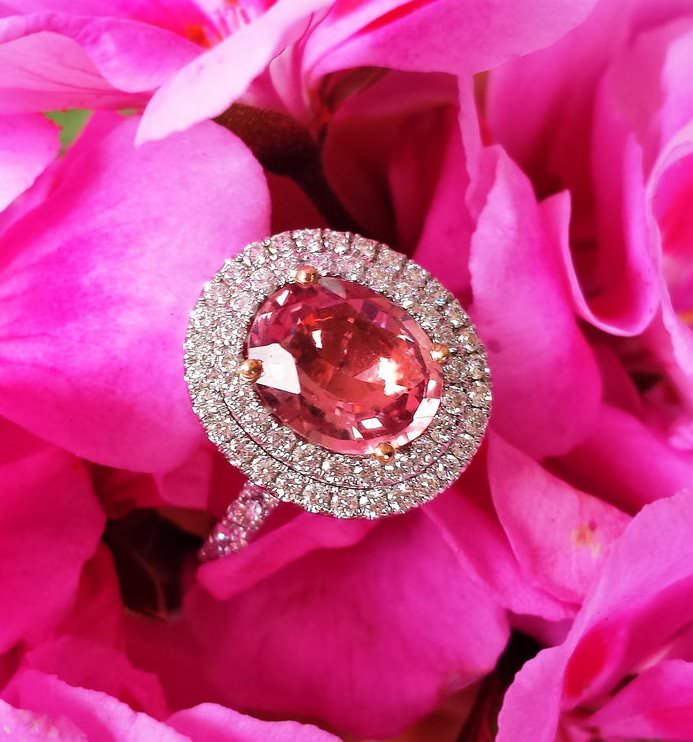
Padparadscha sapphire and double halo diamond ring from the DEEDEE archive
Sapphire is the second hardest mineral after diamond and belongs to the corundum mineral family. Sapphire occurs in all colour varieties: the traditional colour is blue and all other colours are referred to as "fancies" including spectacular yellows, radiant oranges and vivid pinks. The most prized fancy is the exquisite orange-pink "padparadscha" named for the Sinhalese lotus flower. The only colour a sapphire cannot be is red because the red variety of corundum is known as ruby. When the term sapphire is used without the prefix of another colour or the term fancy, it refers exclusively to the blue variety which ranges in hue from pale to deep royal blue through to dark inky blue. High value sapphires are clear with an intense colour which displays a powerful sparkle from its depths. The most revered colour is the velvety cornflower blue known from Kashmir in the north of India. Other important sources are Madagascar, Thailand, Sri Lanka and Myanmar. Australia produces the best fancy greens and also blues which typically have greenish overtones ranging to a dark inky blue.
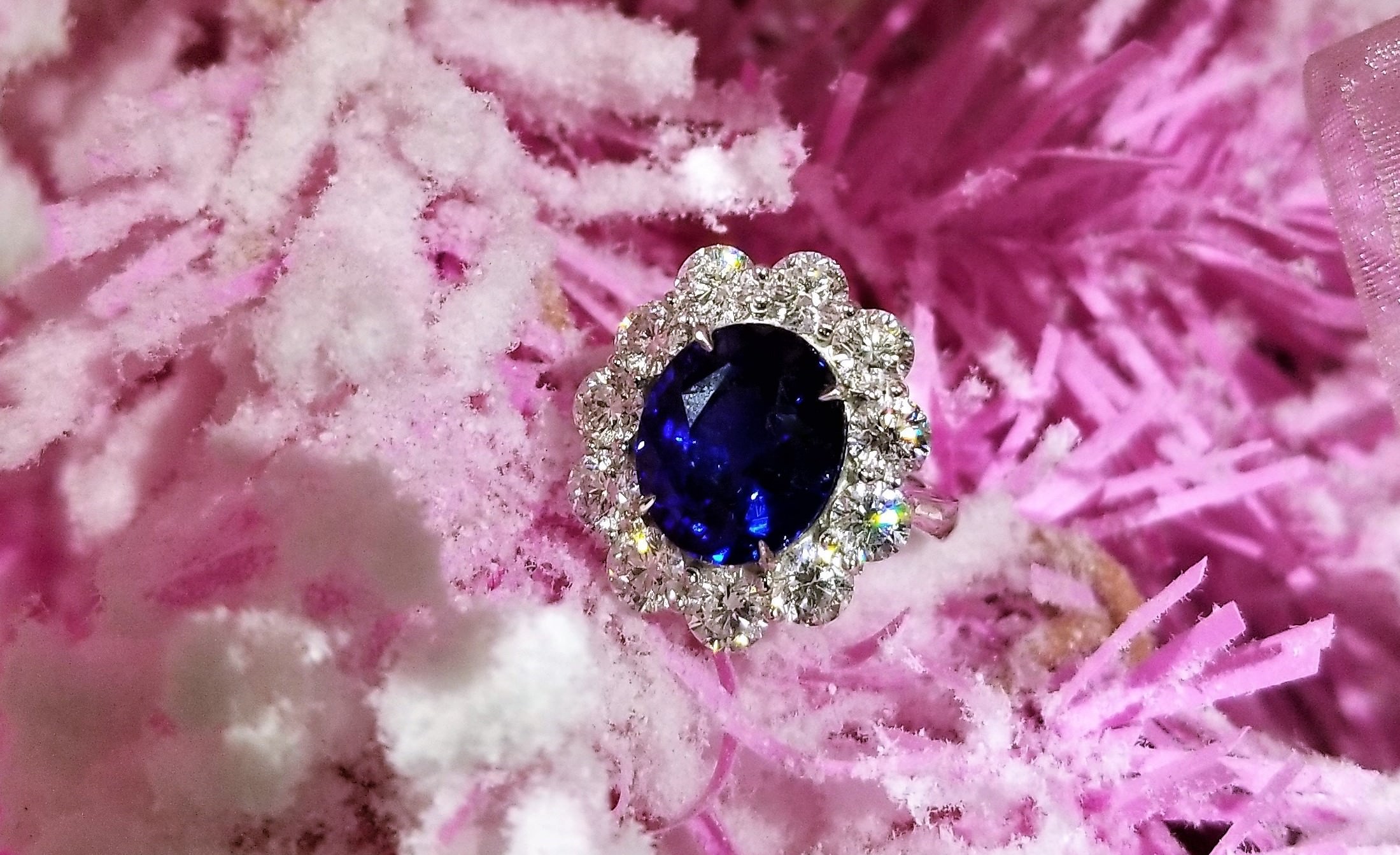
Classic sapphire and diamond ring from the DEEDEE archive
Sapphires can also display asterism, a phenomenon which produces 6 or 12-rayed stars. Chatoyancy, or cat's eye effect, is known but rare. Both of these stones are cut as cabochons and popular in men's rings.
Recently a greater proportion of sapphires are receiving oil treatment so care should be taken with mechanical cleaning as it can remove the oil. Heat treatment of sapphire is common and accepted practice. Caution should be used with high heat as it can damage stones with many crystal inclusions. Sapphire can be cleaned with warm water, mild soap and a soft brush. Sapphire is the birthstone of September, the gift for the 45th wedding anniversary and commemorative of a 65th jubilee.
RUBY
Ancients believed ruby surpassed all other precious stones in virtue. The Chinese Emperor Kublai Khan was said to have offered an entire city in exchange for a prized ruby. Today, ruby remains symbolic of passion, protection and prosperity.

Ruby and diamond earrings from the DEEDEE collection
Ruby is the red variety of the mineral corundum taking its name from the Latin "rubeus" meaning red. High value rubies are transparent with a rich intense colour and a vibrant inner sparkle. Ruby occurs in a variety of shades of red ranging from deep pink-red to orangish-red to red with a distinct violet tone or a deep wine colour. Lighter colour reds are in reality pink sapphire as the colour pink is essentially a desaturated red. In some markets it is common for such stones to be sold as ruby but most consider this technically incorrect: ruby must be predominantly of red hue. Colours are dependent on origin. The most valuable colour rubies are those termed "pigeon's blood" defined as a pure, deep rich red with a hint of blue from the Mogok district of Burma. Burma is now Myanmar although it is common convention to continue referring to these stones as Burmese rubies. Other important sources of ruby are Thailand and Sri Lanka as well as Pakistan, Afghanistan, Zambia, Greenland and Kenya.
Extreme hardness and durability make ruby an excellent gemstone for rings. Rubies can also display asterism, a phenomenon which produces 6 or 12-rayed stars. Chatoyancy, or cat's eye effect, is known but rare. Both of these stones are cut as cabochons. Increasing incidences of oiling ruby have been seen over recent years and care should be taken with mechanical cleaning as this can damage or remove the oil. Heat treatment of ruby is standard practice. A preponderance of inclusions can weaken its normally tough structure. Ruby can be safely cleaned with warm water, mild soap and a soft brush. Ruby is the birthstone of July and the gift of the 40th wedding anniversary.
EMERALD
Emerald represents loyalty, compassion and unconditional love. It has been prized as a gemstone for millennia. Dedicated to goddess Venus by the ancients, treasured by Cleopatra and worshipped by the Incas, emerald holds a place of high honour in virtually all religions.
Emerald is the more valuable of the two principle commercial varieties of the mineral beryl, the other being the pale blue aquamarine. Only gems that are medium to dark in tone are considered emeralds; light-toned green gems are known by the species name "green beryl." Other colours of beryl are referred to by their species name or by their colour: rich yellow or golden colour (heliodor); pink (morganite); red (bixbite); and colourless (goshenite).

Magnificent emerald and diamond ear pendants from the DEEDEE collection
Emerald occurs in hues ranging from yellow-green to blue-green with the primary hue necessarily being green. Yellow and blue are the typical secondary colours. The finest colour is a pure green which is medium dark in tone. By definition in most of the world emerald must be coloured by the element chromium; however, in the 1960s the American jewellery industry accepted labelling green beryl coloured by vanadium as emerald. Such stones are not recognized as emerald in the UK and Europe. The term "Colombian emerald" refers exclusively to chromium-coloured emeralds and these stones are the finest in the world. Brazilian emeralds are smaller and of lower quality than the finest Colombian stones; some are very dark green with profuse inclusions and some are coloured by vanadium and have little, if any, chromium. Emeralds also originate in the Ural Mountains of Russia, India, Zambia, Zimbabwe and South Africa.
Flawless emeralds are exceedingly rare, most emeralds are characteristically included or highly included with surface breaking fissures which make their toughness, meaning resistance to breakage, generally poor. As such they are often described as brittle. Like all coloured gemstones emerald is graded using the traditional 4 C's: colour, clarity, cut and carat weight; however, unlike other gemstones for which colour is by far the most important criterion, clarity is a significant factor with emeralds and graded without magnification. Therefore, if there are no visible inclusions to the eye with normal visual acuity the emerald is considered flawless.
Stones that lack surface breaking fissures are extremely rare and therefore almost all emeralds are treated by "oiling" to enhance the apparent clarity and this is accepted practice. Sometimes the oil is drawn into the cracks in a vacuum chamber to draw air out of the fractures and draw the oil into the fractures. The oil may bleed out with gentle heating and household cleansers rather easily remove it, so the stone will be affected if worn when washing. The ultrasonic cleaner is very damaging to emerald overall but it readily damages the appearance of oiled stones by removing the oil. Even if handled delicately, over time oil has a tendency to dry out and reveal the fractures. Low melting point resins, such as Canada balsam or an epoxy resin such as Opticon, are more durable and when performed must be disclosed. Coloured oil or resin is also used for emeralds, it greatly improves the apparent colour as well as transparency but it is considered a fraudulent practice. The colour may fade and the oil still bleeds out with gentle heating. All emeralds should be treated with exceptional care. Mechanical cleaning can be very damaging to the oil, as can excessive heat and harsh detergents. Cleaning in warm water with a very soft brush is recommended and a very mild soap may be added but do not leave the stone to soak.
In order to be considered as a fine gemstone emerald must possess a high degree of transparency as well as a luxurious green hue. Emeralds tend to be cut into an octagon shape. This cut has come to be known as the emerald-cut even when used on other gemstones, including diamond. Emerald is the birthstone of May and the traditional gift for a 55th wedding anniversary.
AQUAMARINE
Aquamarine comes from the Latin "aqua marinus" meaning "water of the sea" referring to its glimmering ocean-like colour. Historically, it was held to be the treasure of mermaids and was used as a talisman of good luck for those traveling near or over water.
Aquamarine is the pale to sky blue to bluish-green variety of the mineral beryl. It is found in most locations where ordinary beryl is found. The finest aquamarine is sky blue yet even if an aquamarine is deep in colour it never rivals the fine blue hue of sapphire. It is not uncommon for aquamarine to occur in large flawless crystals although smaller stones are far more prevalent. Aquamarine scores 7.5 on the Mohs' scale and is less brittle than emerald; however it should still be worn with care. Practically all fine blue aquamarine is heat-treated greenish-yellow or brownish-yellow material and this change is permanent and acceptable in the gem trade. Some heat treated stones have been known to fade in response to further heat and therefore it is wise to avoid exposing aquamarines to excessive hot water and store them out of direct sunlight as an added precaution. Aquamarine can be safely cleaned with warm water, mild soap and a soft brush. Aquamarines are found in Brazil, Russia, California, Madagascar and Myanmar. Aquamarine is typically eye-clean but under the microscope inclusions are visible. Aquamarine is the birthstone of March.
TANZANITE
Tanzanite is the blue variety of the mineral zoisite. It ranges in colour from deep ultramarine blue to light violet-blue. The most coveted colour is a strong velvety blue with a hint of violet. Compared to other fine gems tanzanite is a relative newcomer to the world of fine jewellery. It was first found in 1967, making it the newest gem discovered. It is celebrated as the Gemstone of the 20th Century.
Tanzanite is rare and costly in fine quality. It occurs in only one place in the world at an extremely small mining area only 7km long and 2km wide in the Merelani Hills at the foot of Mount Kilimanjaro in Tanzania. It takes its name from its country of origin.
When mined, tanzanite is noted for its very strong trichroism meaning it shows three colours from three different angles appearing brown, blue and violet concurrently depending on viewing angle. Nearly all tanzanite is heat-treated to produce the striking violet-blue colour. This heating can occur naturally underground by metamorphic processes or above ground by man in a furnace. In both cases heating removes the brown colour component leaving the stone showing two colours from two different angles - those being blue and violet and ranging from bluish-violet to indigo and violetish-blue to blue. Some stones found close to the surface in the early days of discovery in the area now referred to as D block of the mine were gem-quality blue when mined. It is believed this was the result of a wild fire in the area which heated the stones underground. Stones from D block are the most valuable and desirable. Tanzanite can also appear different colours under different lighting conditions appearing bluer under fluorescent light and more violet under incandescent light. Virtually all tanzanite is heat treated and this creates no difference in value.
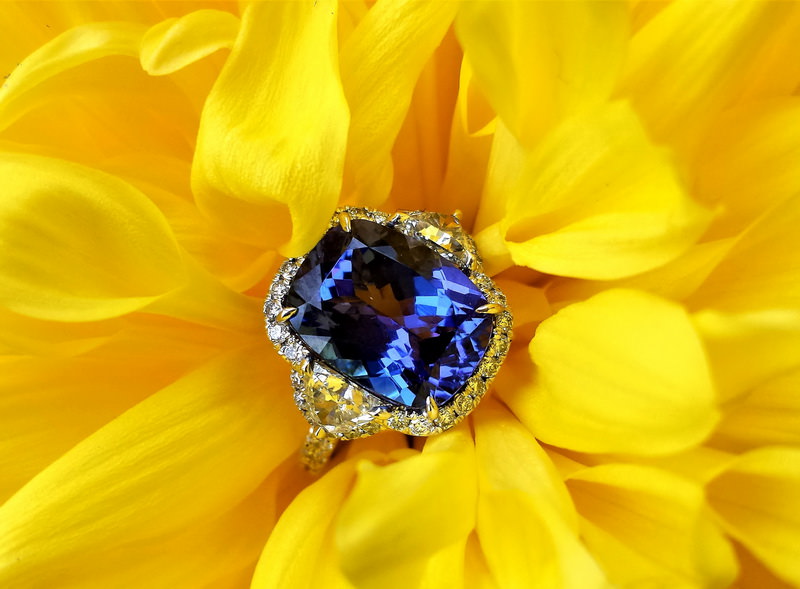
Tanzanite and diamond ring from the DEEDEE archive
In response to the fact that there is no universally accepted method of grading coloured gemstones, the Tanzanite Foundation introduced its own colour grading system dividing tanzanite into a range of hues between bluish-violet, violet, indigo and violetish-blue. Tanzanite is normally eye-clean and is graded as flawless if no inclusions are visible with the unaided eye. Gems with eye-visible inclusions and paler colour are considered far inferior in demand and price.
It is not especially durable with a Mohs' hardness of only 6 and it should always be worn with care as it is sensitive to heat and vibrations. Tanzanite is a relatively soft and brittle gemstone that is susceptible to chipping or breaking if knocked. Tanzanite can be cleaned with warm water, mild soap and a soft brush. In 2002 the American Gem Trade Association named it the birthstone for December, marking the first change to this established list since 1912.
GARNET
Garnet was prized as far back as the Bronze Age. Known as the most popular gemstone of Ancient Roman and Greek civilizations it has enjoyed popularity as both a talisman and gemstone for the better part of 5000 years. Although garnet is most well-known as the popular dark red gemstone, garnets come in exotic varieties of exquisite colour which are regarded as high quality gemstones. Some of these can stand on par with ruby, sapphire and emerald in beauty and value. These garnets are very important gemstones in fine jewellery.
Garnet is found the world over and derives its name from the Latin word "granatum", a pomegranate, because of the resemblance the red varieties bear to the seeds of that fruit. The traditional red garnets are pyrope, usually blood red colour, and almandine, dark intense red to purplish-red. These are found most often in commercial jewellery because they are abundant and inexpensive. Some show asterism with 4 and 6-rayed stars. The garnet known as rhodolite is two-thirds pyrope and one-third almandine. It is a light to dark purplish-red or reddish-purple. It must have some purple component and in finer qualities is quite seductive. Rhodolite was originally found in North Carolina and sources include: Kenya, India, Sri Lanka and Madagascar. Hessonite is orange-red to honey yellow. Hessonite is found in Sri Lanka, Canada, Tanzania and Madagascar.
Spessartite is a rarer variety of reddish-orange to yellow-orange-brown. Pure orange occurs but is not common. The most prized colour is a fiery-red with orange tints. Originally found in the 1960s in the Umba River of Tanzania and Kenya it was once fairly uncommon in gem grade however more recent finds of higher quality are causing a surge of interest in the stone. Spessartite exhibits exceptional brilliance and stones are bright, lively and captivating. Spessartite is not enhanced and its beautiful colours are always natural. It is usually found in granitic pegmatites in Tanzania, Kenya, Nigeria, Namibia, Mozambique, Brazil and California.
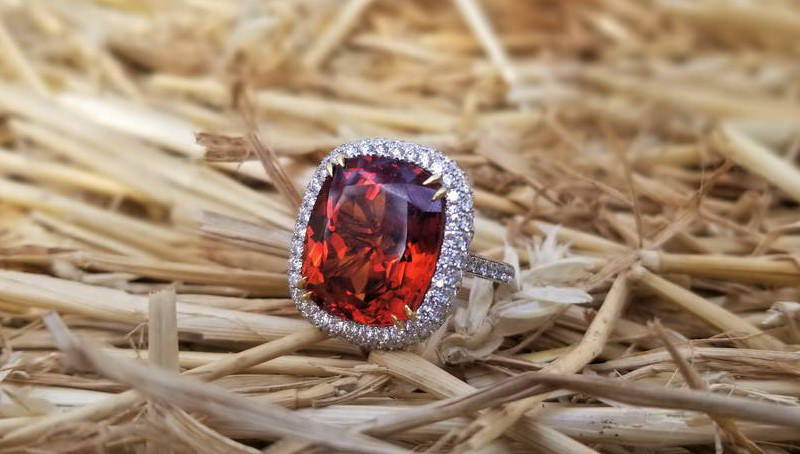
Spectacular spessartite and diamond ring from the DEEDEE collection
Tsavorite is one of the most popular and expensive garnets. It was first discovered in Tanzania in 1967 and later in 1970 in the same geological formation across the border in Kenya near Tsavo National Park wildlife preserve after which it was named. It is coloured by vanadium and displays a bright, rich colour that is very much like emerald. It is commonly used as an alternative stone to emerald because it exhibits far fewer inclusions and on occasion can be flawless. It is much rarer than emerald and large fine Tsavorites command a high premium. The best colour is emerald green, the lighter tones and yellowish hues are less desirable. The green colouring is caused by trace amounts of the elements chromium or vanadium.
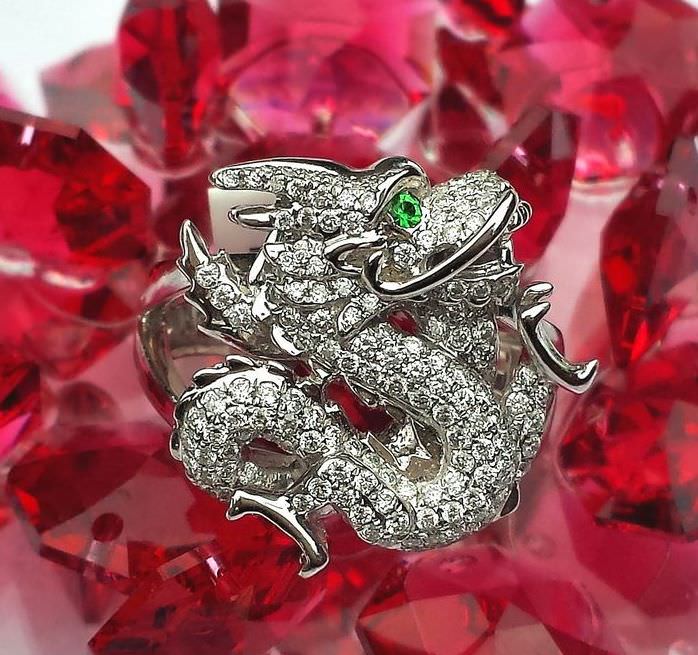
Diamond-set dragon ring with an electrifying tsavorite eye from the DEEDEE collection
Demantoid is another commercially significant transparent bright green variety of garnet. Demantoids are always primarily green (by definition) but the exact shade ranges from a very strong yellowish green to nearly the colour of a fine emerald. It is coloured by chromium, the same element responsible for the finest green colour in emeralds. Although garnets have been known since ancient times, the demantoid variety was not discovered until 1868 in Russia's western central Ural Mountains. Prized for its high lustre, brilliance and dispersion it gives it a "fire", rainbow-coloured flashes of light, which exceeds that of diamond. Miners began comparing it to diamond and referred to it as demantod after the French term "demant" meaning diamond. The commercial deposits are in Russia, Namibia and Madagascar. Demantoids are generally small with facetted stones generally under 1 carat. Two carat stones are rare and stones over 3 carats exceedingly rare.
Garnet is a beautiful series of gemstones usually sold without treatment of any kind. It is also durable and scores between 6.5 and 7.5 on Mohs' scale making it suitable for wearing in most types of jewellery. Garnet jewellery can be cleaned easily at home by warm water, mild soap and a soft brush. Garnet serves as a birthstone for the month of January and is a traditional gem given on a second anniversary.
TOURMALINE
Tourmaline is a colourful family of gemstones. Virtually all colours are known. Fine and exotic colours can command very high prices, among them the reds, greens and blues. The most expensive variety is the rare neon-blue paraiba tourmaline. Paraiba tourmaline was first discovered in 1989 in the Brazilian state of Paraiba from which it takes its name. It soared in popularity in a very short time causing the cost to become astronomically high due to short supply. Small deposits of similar colour have been recently found in Nigeria and Mozambique.

Chrome green tourmaline and diamond cufflinks from the DEEDEE collection
Green tourmaline is highly regarded. The most prized of the greens is an intense and vibrant green stone owing its colour to chromium referred to as chrome green tourmaline. Chrome green tourmaline is found in Tanzania. Rubellite is the pink to red variety. Its colour can vary from red to violet and through pale to dramatic pink. Its name comes from the Latin word "rubellus" which means reddish. It is one of the most prized and expensive members of the tourmaline family because of its beauty and rarity.

Rubellite and diamond ring from the DEEDEE archive
Dichroism is strong in darker coloured stones and usually shows as light and dark colours of the same hue. Tourmaline can be found in fairly large transparent crystals and these can produce very large exquisite and flawless gemstones. Brazil is known for red, green, yellow, blue and parti-coloured varieties. Russia is known for red, green and blue. Other sources are: Sri Lanka, Madagascar, Namibia, Russia and Myanmar.
Heat treatment is sometimes undertaken to enhance colour: it can lighten dark Brazilian green and blue to appealing colours and it can alter lighter greens to deep green and some brownish-red stones can be made attractive red. Irradiation can also alter colour: colourless, very pale pink, green or blue can produce striking pink to red to purple stones.
Tourmaline scores 7.5 on the Mohs' scale making it suitable for wearing in most types of jewellery. However, a reasonable level of care should be taken when wearing tourmaline pieces, particularly rings because it can have a tendency to be brittle. Pink tourmalines are often flawed and such stones may be structurally weak and vulnerable to vibration damage with mechanical cleaning. They exhibit moderate sensitivity to heat. Tourmaline can be cleaned in warm water with mild soap and a soft brush. It is the birthstone for October.
PERIDOT
Peridot is a fascinating, ancient and under-appreciated gemstone. Peridot has been found in jewellery dating back to the Pharaohs of Egypt. It is the gem variety of the mineral olivine. Peridot can be pronounced both with and without the "t" at the end. Peridot is one of the few gemstones that form only in one colour. It is always green although it varies from bright yellow-green, lime or pure green, to deep olive or brownish-green; the most valued being a rich saturated grass green colour.
Peridot is often overlooked by fine jewellery lovers because they are most familiar with the small and inferior stones commonly appearing as the birthstone for August but peridot in its finest form is a remarkable stone. The Gemological Institute of America calls peridot the "extreme gem" because it is one of only two gems (diamond is the other) which forms below the Earth's crust in the molten rock of the upper mantle and is brought to the surface by the tremendous forces of earthquakes and volcanoes. Crystals of peridot have been found in meteorites formed some 4.5 billion years ago, remnants of our solar system's birth. Peridot in its basic form, olivine, was also found in comet dust brought back from the Stardust robotic space probe in 2006 and has been discovered on the moon.
The ancient source of peridot was the tiny Egyptian island of St. John (Zabargad) in the Red Sea, now a totally exhausted deposit. Since the 1990s significant deposits of large transparent peridot from Myanmar, China, Afghanistan and especially Pakistan have provided an exceptional quality far surpassing anything previously discovered. Many peridots, especially older ones which pre-date the newer finds, have cloudy or milky inclusions. Today, large nearly flawless crystals which cut to magnificent gemstones are rekindling interest in this gemstone.
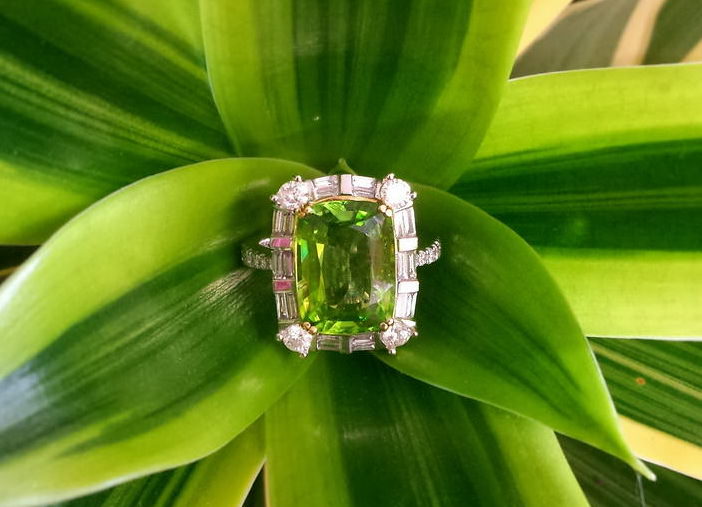
Peridot and diamond ring from the DEEDEE archive
Exceptionally beautiful in its finest quality, peridot is both a day stone and a night stone, keeping its admirable colour even under artificial lighting causing it be nicknamed "evening emerald." It occurs for the most part as an eye-clean gem with excellent transparency and is typically faceted. Peridot is rarely heat treated; however; some are oiled to improve appearance.
Peridot is not a very durable gemstone. It has a lower hardness than many gemstones, 6.5 on Mohs' scale, making it more prone to scratches. It is best suited to pendants and earrings or rings in which it is surrounded by diamonds for protection. Acids, even those in perspiration, can damage peridot and thus it should be worn directly against the skin only rarely. It cannot withstand intense heat or rapid temperature changes. Peridot can also chip if banged hard and should never be steam cleaned or cleaned with an ultrasonic cleaner. Cleaning with warm water, mild soap and a soft brush is safe.
TOPAZ
For thousands of years, topaz has been thought of as a symbol of opulence and luxury. Topaz forms in various tones and saturations of yellow, gold, orange, red, blue, green, purple and brown as well as colourless. Topaz is an ideal gemstone and topaz of all different colours is used in rings, earrings, necklaces, pendants and bracelets. Topaz takes its name from the ancient and obscure Topazios Island in the Red Sea now called Zabargad. However, the island never produced topaz but was a main source for peridot. Some scholars trace the name's origin back to Sanskrit, the ancient language of India, where the word "topas" or "tapaz" means fire. In the past, the name topaz was used indiscriminately for many yellow stones, in particular yellow citrine from Brazil. This caused true topaz to be referred to as precious topaz. The name topaz should only be used to refer to the mineral topaz. Similarly, the stone smoky topaz is a misnomer too; it is actually smoky quartz.
Colourless and shades of pale blue are most common; yellow through to brownish-yellow/yellowish-brown to orange (often described as sherry brown) and blue to green also occurs naturally. Red and pink colours are rarely found naturally; the most valuable is Imperial topaz. The term "Imperial Topaz" originated in 19th century Russia, where the Ural Mountains were topaz's leading source. The rare distinct vivid pinkish-orange to red-orange colour gemstones discovered there were named to honor the Russian czar and ownership of these stones was restricted to the royal family. True Imperial topaz is always untreated and any material which has been coloured by artificial means is never regarded as genuine Imperial topaz. The principle source today is the Ouro Preto mines of Minas Gerais, Brazil.

Blue topaz and diamond ear pendants from the DEEDEE collection
The most common topaz seen in jewellery today is blue topaz although it was not until the 20th Century that blue topaz was widely used in jewellery. This is because virtually all gem blue topaz owes its colour to irradiation and heat treatment which produces a distinctive range of blues. Blue topaz does occur in nature but is rare and almost always lightly coloured and the radiation process gives them their deep sky-blue colours. The colour is generally stable, undetectable and an accepted practice. London Blue refers to medium to dark greyish-blue which is often described as somewhat inky. Swiss Blue refers to darker blues without inkiness. Sky Blue refers to the brighter lighter blues. Heat treatment also produces pink from brown material.
In general, topaz is a fairly common and inexpensive gemstone. A great deal of topaz is inclusion-free. It is highly transparent with a vitreous luster and is found around the world. Huge and flawless crystals weighing up to 220 pounds have been discovered and many have been cut into giant gemstones weighing thousands of carats found in private collections and museums.
Topaz is a hard, Mohs' scale 8, and durable gemstone; however, it does have perfect cleavage which can make it prone to chipping if banged hard enough. Topaz is also susceptible to heat and vibrations making mechanical cleaning a risk. Topaz can be cleaned with warm water, mild soap and a soft brush. Topaz is the birthstone of November.
AMETHYST AND CITRINE
Amethyst and citrine are both members of the crystalline quartz family. Amethyst has been highly esteemed throughout the ages for its stunning beauty. To ancients it was a "gem of fire" and at times in history enjoyed as much demand as diamond. It has a long association with February, the month the Romans dedicated to Neptune their water-god and it is the traditional birthstone of that month. Amethyst is one of the most common and popular gemstones known today deriving its name from the Greek "amethystos" which means "not drunken" as it was believed in legend to ward off drunkenness. It is found world-wide and enjoys popularity across the globe for its beautiful purple colour ranging from faint mauve to violet-purple. Amethyst often shows angular zones of colour and slight to distinct dichroism: bluish-purple and reddish-purple. The historical source is Russia associated with beryl and topaz. Present-day sources include: Brazil, United States, Canada, Myanmar and Madagascar. Amethyst is often heat treated to deepen the colour or to transform it into citrine.
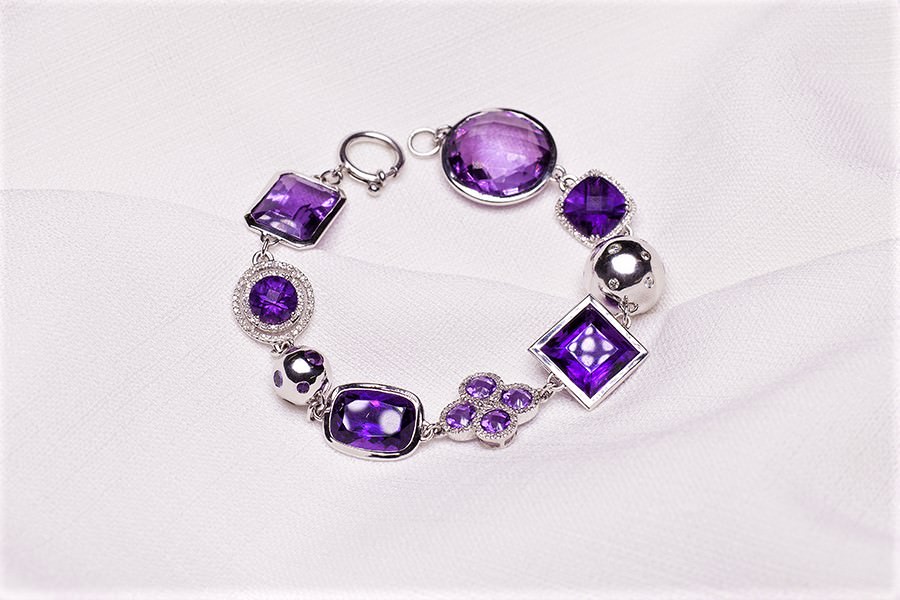
Amethyst and diamond LUDO bracelet from the DEEDEE collection
Citrine is the yellow variety of quartz, ranging in colour from pale to golden yellow, honey or reddish-yellow and owes its colour to a trace of ferric iron. It is widely used as a gemstone and the finest is from Brazil. The name comes from the French word "citron" meaning lemon. It was used as a gem in Greece as far back as 300 B.C. Much of the commercial citrine on the market is heat-treated amethyst or smoky quartz that produces a deeper amber or orange-reddish shade. In some amethyst deposits, the amethyst has been partially or fully altered to yellow citrine by natural means of heating. Natural citrine, which is rare, is yellow to orange-yellow and occurs in much lighter hues than the heat-treated material. Virtually all heat-treated material has a reddish tinge. Most commercial gem-grade material comes from Rio Grande do Sul and Minas Gerais. A classic exhausted locality for natural citrine is Olkhovka in the Northern Ural Mountains, Russia.
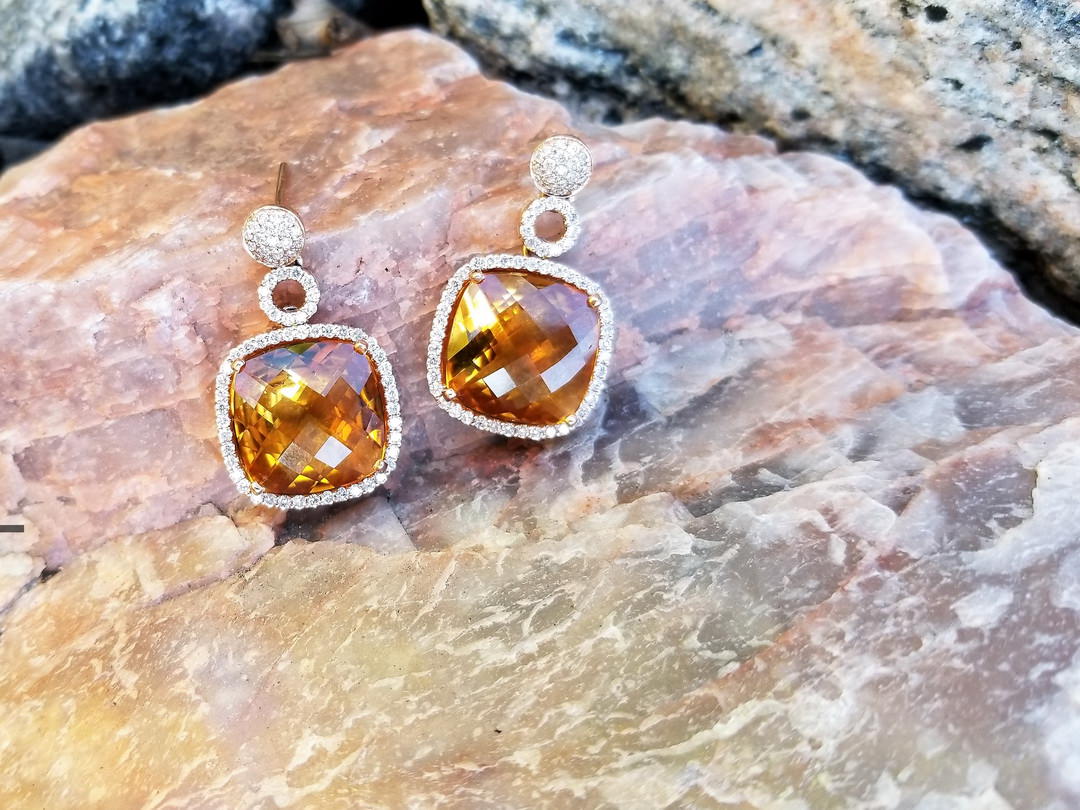
Checkerboard citrine and diamond earrings from the DEEDEE archive
Both amethyst and citrine are 7 on Mohs' scale making them suitable for wearing in most types of jewellery on a frequent basis providing a reasonable level of care is taken.
Avoid exposing your amethyst or citrine to extreme temperatures such as hot water or long term exposure to direct sunlight. The majority of these gemstones will have been heat treated to enhance their colour and heat can reverse the original treatments causing them to fade. Quartz jewellery can be cleaned with warm water, mild soap and a soft brush.
SPINEL
Spinel has been used in jewellery since ancient times although for much of that time it was thought to be ruby or sapphire since it originates from the same mines. After the rise of modern gemmology it came to be recognized as a mineral in its own right. Spinel is commonly found as water-worn pebbles. Spinel is available in virtually any colour although the most commercially important colours are: red - the best is a deep intense red like the colour of fine ruby but more common are paler reds and those that are orangish, brownish or purplish; and blue - varies from rich blue like that of fine sapphire to paler greyish-blue or greenish-blue. Fine cobalt blue spinel does occur but is very rare.
Myanmar is a source of fine red, pink and blue. Sri Lanka is known for blues and violets but produces a full range of colours. Other sources include: Kenya, Tanzania, Australia, Brazil, Afghanistan and Pakistan. Thailand, contrary to many sources, is only a source of black spinel. Spinel is characteristically a clean stone with few inclusions.
Natural spinels in the market today are almost all untreated. Hardness is Mohs' 8 making them suitable for wearing in most types of jewellery on a frequent basis. They are hard and durable and have no special care requirements. Spinel jewellery can be cleaned with warm water, mild soap and a soft brush. Mechanical cleaning is also safe.
PEARL
Chief among organic gems is that prized possession known as the pearl. It was one of the first gems worn. Practically all shelled molluscs have the ability to produce substances which together create pearls and mother of pearl, but it is only in certain types that gem-quality nacreous pearls, pearls as we know them, are formed. Natural pearls form without human intervention. They are exceedingly rare in the marketplace today although for many centuries this was the only type of pearl known.
Cultured pearls form with human intervention and are cultivated on a pearl farm. Almost all pearls on the market today are cultured. If a foreign body gets between the shell and the soft body of a suitable mollusc and the animal cannot expel it, it takes steps to cover the uncomfortable intruder with nacre, thus producing a pearl. Experimentation began centuries ago into methods to induce pearl-forming animals to produce pearls. Mikimoto was the first to market fully spherical cultured pearls but he is not the inventor of the process. In all likelihood this is Tatsuhei Mise, who prior to 1904 produced a pearl in the species Pinctada martensii. The controlled conditions keep the oysters in shallow waters that never reach below 10℃. The typical cultivation period is 3.5 years and oysters fished up in a shorter period, such as 12-18 months, will have thinner, less beautiful, less durable, nacre. Most of the cultured pearls are grown in inland waters of Japanese bays.
Traditionally "pearl" with no qualifier was used to denote only natural pearls; however, these are virtually non-existent today so the term has begun to be applied to the cultured pearl. Another general categorization of pearl is saltwater, from the oceans or seas, or freshwater, from rivers and lakes. In general, saltwater pearls are markedly more valuable.

Tahitian pearl and coloured diamond and gemstone necklace from DEEDEE collection
Pearls of all types are judged and priced on a number of factors: (1) size - the larger the pearl, the rarer and more valuable it is; (2) lustre - the brilliance of the pearl. The beautiful spectral-coloured lustre of pearls, an effect termed "orient" is seen on mother of pearl shell and on only the finest pearls. It is an optical phenomenon in which spectral rainbow colours move across the surface in response to movement of the pearl, the light or the observer. High lustre pearls display strong bright light reflections although not necessarily orient, and those of low lustre look dull and milky; (3) surface blemishes - the number and size of the blemishes. Some blemishes are normal and the smaller and less obvious they are the better the pearl; (4) shape - in general, the more a pearl deviates from perfectly round the less valuable it is; (5) colour - white and pinkish salt water pearls are most highly valued and pink overtones are most desirable. Natural blacks are also highly valued as long as they have overtones. White South Seas are the most prized but golden-yellow can be just as valuable. With freshwater pearls the price is more variable with demand; and (6) nacre thickness - the thicker the nacre the more valuable the pearl, thick nacre produces both beauty and durability.
The hardness of pearl is about 2.5 to 4 on Mohs' scale. Pearls will hold their beauty and value for centuries if they are properly cared for but owing to its organic nature pearls are not as durable as mineral gems. They are much softer and easily scratched by other jewellery so they should always be stored separately. Avoid storing pearls in cotton wool as it often contains acids. Moreover, pearls have a tendency to lose lustre and exhibit cracks due to drying out. Pearls draw moisture from the air so storing your pearls in a dry area such as a safety deposit box can sometimes do more harm than good. Heat can also remove the natural moisture in pearls. Avoid direct contact with sprays and perfumes and clean pearls regularly. Pearl necklaces, as they are worn on the skin most often, should be wiped down with a soft cloth after every wearing because the skin produces acids that can be absorbed by the pearl which will eat into the pearl causing it to lose its lustre.
Pearl necklaces and bracelets should be laid on a soft cloth and gently cleaned with a new, clean makeup brush and warm water. If there is some persistent material adhered to the pearl's surface you can use a tiny amount of mild dish soap which you should rinse off immediately. When cleaning, pay particular attention to the areas of the drill holes because foreign matter retained here can cause irreversible damage by deteriorating the organic nacre resulting in discolouration and loss of lustre. Do not immerse a pearl strand in water as it stretches the silk thread and the pearls will become loose. When wiping the pearls dry do not pull on the silk thread. The best idea is to roll them gently on a dry cloth and leave them lying flat to finish air drying. Pearls should be restrung every six months if worn very frequently.
Natural pearls can be 'skinned', meaning that a poorly coloured or blemished layer is removed by careful abrasion. Cracks can be 'cured' by careful soaking in warm olive oil.
Cultured pearls can be stained rosee by bleaching in hydrogen peroxide and then soaking in a dye made of vegetable oil. Black colour is induced by silver nitrate as it is with natural pearls. Bleaching is used to lighten or remove the undesirable greenish tint. It is not detectable and is accepted practice.
MORGANITE
Morganite is the pink to purplish-pink variety of beryl. The beryl family is best known for its gemstone varieties emerald and aquamarine. Morganite is pastel or pale in colour by nature, known for its transparent peach-pink colour although it also occurs as soft pink, violet-pink or pale salmon. Unlike emerald which tends to have significant inclusions, morganite is relatively free of inclusions. Another rarity is its availability in large rough crystals, making big faceted stones possible. Discovered in California in the early 1900s this crystal was known as pink beryl until 1911 when at the suggestion of George F. Kunz, the chief gemmologist at Tiffany & Co., it was renamed Morganite in honor of the legendary financier and gem collector J. P. Morgan.
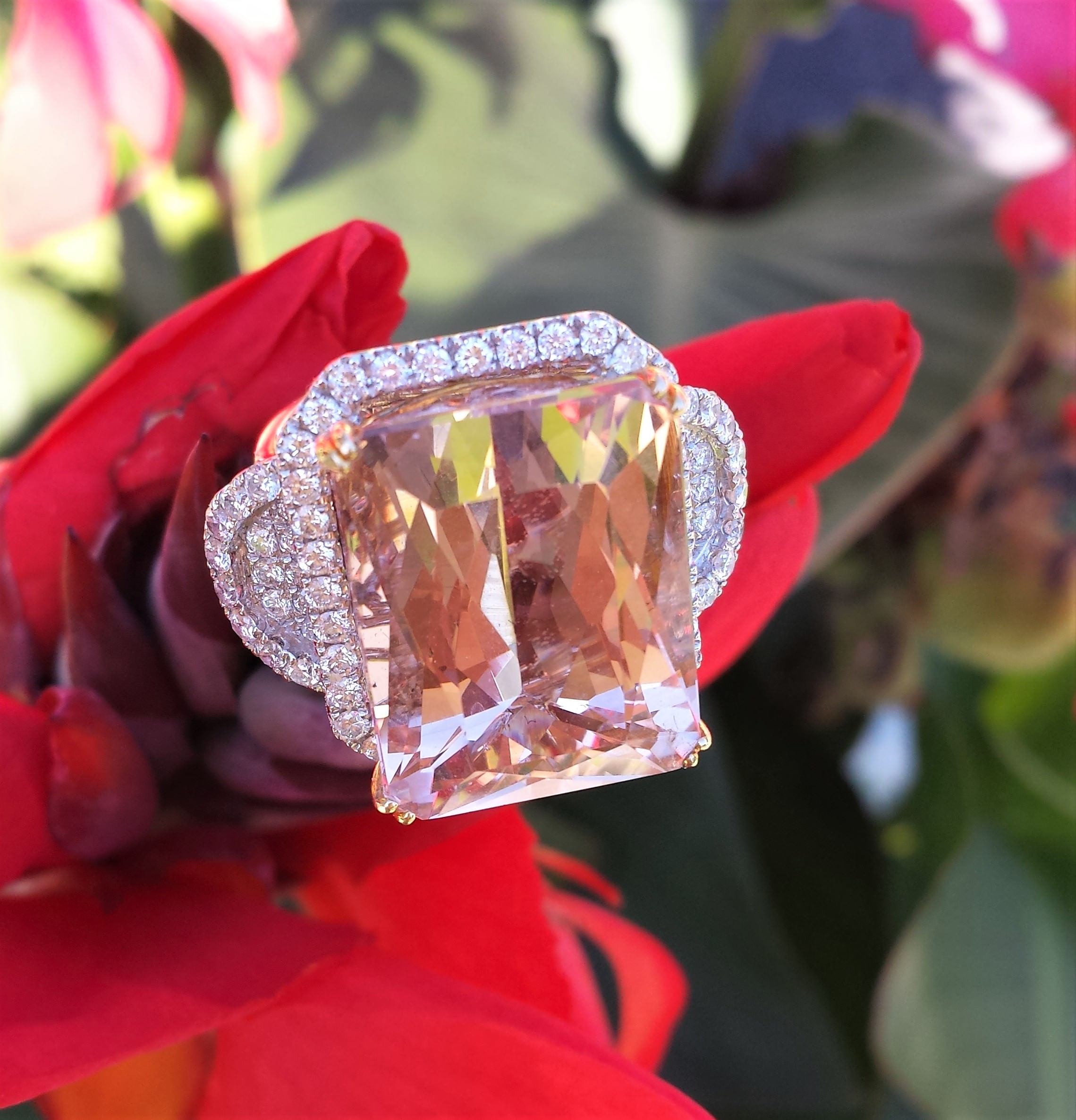
Morganite and diamond ring from the DEEDEE archive
Besides the extremely rare red beryl, morganite is the least common gem form of beryl. The main sources of morganite are Brazil, Madagascar, Afghanistan, Pakistan and the United States (California and Maine). Morganite between 7.5 and 8 on Mohs' scale is suitable for wearing in most types of jewellery on a frequent basis providing a reasonable level of care is taken. Morganite is sometimes heat treated to improve its colour and remove yellowish tones. This can be achieved at relatively low temperatures. Avoid exposing morganite to extreme temperatures such as hot water or long term exposure to direct sunlight which may reverse the original heat treatment. Morganite jewellery can be cleaned with warm water, mild soap and a soft brush.
KUNZITE
Kunzite is named for eminent mineralogist George Frederick Kunz who first catalogued it in Pala, California in 1902. Kunzite is the pink to violet variety of the mineral spodumene; the deeper the pink the more valuable the stone. It is characterized by a glassy transparency and is highly pleochroic shifting from pale pink to light violet and even colourless depending on the angle of observation. In spite of having perfect cleavage (the tendency to readily split when subjected to a sharp directional blow) making cutting difficult, it can be faceted into beautiful gems. Spodumene is common but only in several localities does it occur in transparent gem form. Kunzite deposits are quite extensive and extremely large and flawless crystals have been found. For most of the century since its discovery kunzite was a collector's stone until the 1990s when it started becoming increasingly popular as a mainstream gemstone due to its lovely pink colour.
Kunzite forms naturally as colourless, pink, lilac, yellow and green crystals. Genuine kunzite is quite pale in colour and natural darker shades are higher in value. It is commonly heat treated to intensify its colour and remove brownish tones. There are some heat-enhanced varieties on the market. Kunzite is notorious for its habit of colour fading in prolonged exposure to strong light. Although the colour-fading effect is very slow, most people still prefer to wear Kunzite jewellery in the evening to avoid sunlight exposure. Kunzite is regarded as an evening stone for this reason.
Kunzite rates 6.5 to 7 on the Mohs' scale and is very sensitive to knocks and will chip if hit too hard. It is most often used as a pendant stone and as a large decorating stone on ornamental objects. It is less commonly used in rings, necklaces or other jewelry items where small stones are required. The sources of Kunzite are Afghanistan, Pakistan, Brazil, Madagascar, Mozambique and the United States (California and Maine). Kunzite jewellery can be cleaned with warm water, mild soap and a soft brush.

Loading...
